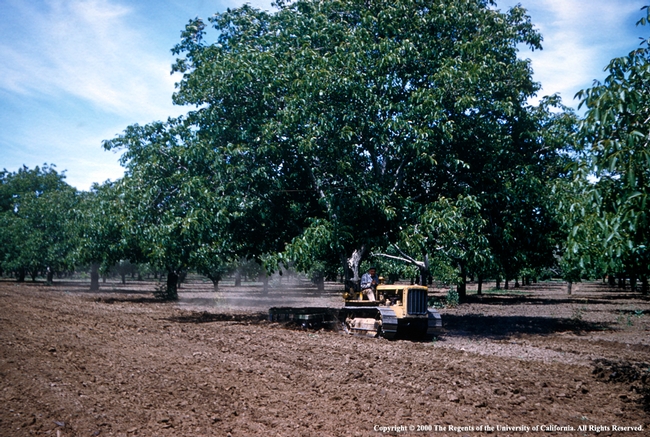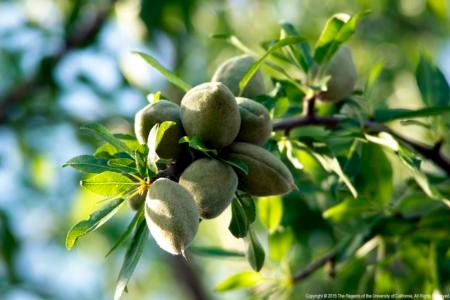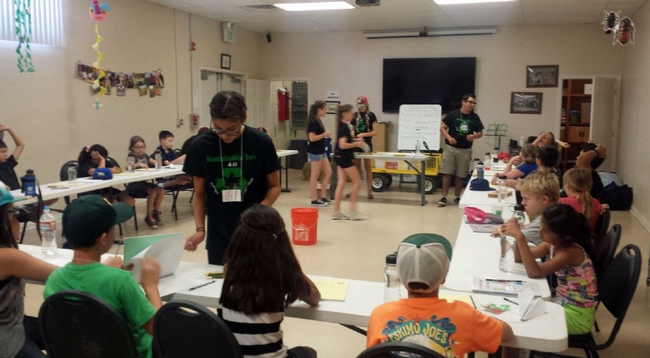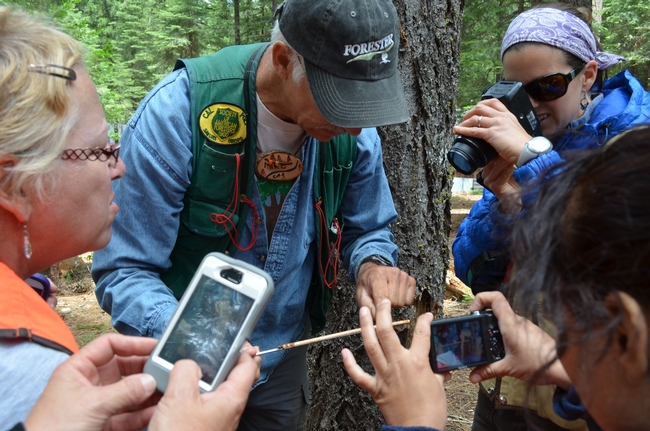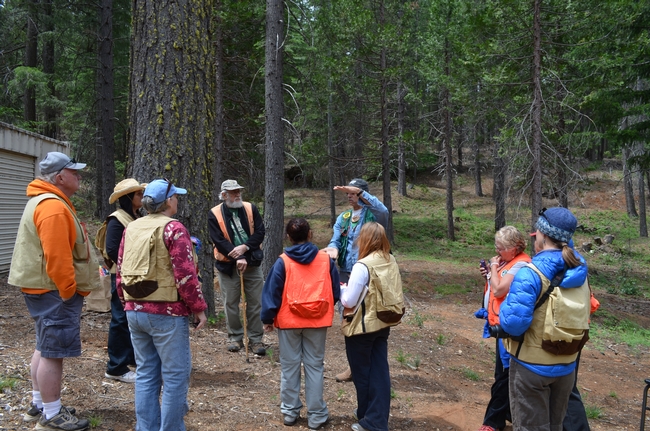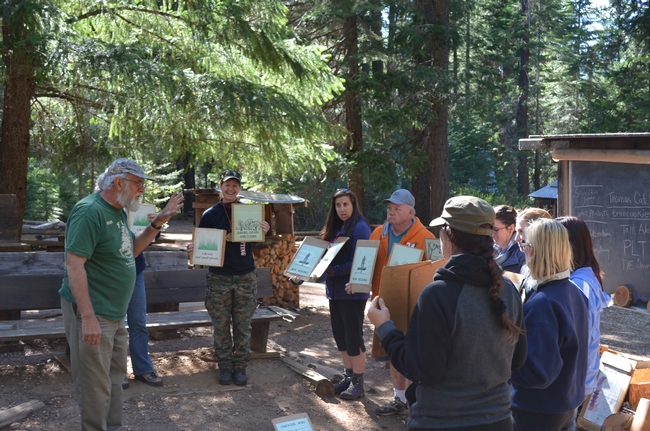Posts Tagged: sustainable
Recording of life-cycle assessment of tree crops webinar posted
Can orchards get credit for storing carbon? A webinar discussing greenhouse gas emissions, carbon sequestration and more is now online.
Sonja Brodt, academic coordinator in the UC ANR Sustainable Agriculture Research and Education Program, and Elias Marvinney, a graduate student in the UC Davis Department of Plant Sciences, hosted a webinar on July 29 to discuss their life cycle assessment analyzing the environmental impacts associated with walnuts, prunes, peaches, almonds and pistachios. The researchers are quantifying energy use and greenhouse gas emissions in orchard crop production both on the farm and beyond.
Research by the UC Davis and UC Agriculture and Natural Resources scientists found that almonds have a relatively small carbon footprint and could become carbon-neutral or even carbon-negative, largely through incorporating orchard biomass into the soil or using the biomass, hulls and shells for renewable power generation and dairy feed.
To watch a free recording of the Life Cycle Assessment of Greenhouse Gas Emissions and Energy Use in California Orchard Crops webinar, go to http://bit.ly/1ITIbKr.
Brodt and Marvinney co-authored two related articles published in the current issue of Journal of Industrial Ecology examining the environmental impact of the almond industry.
The first article, "Life Cycle-based Assessment of Energy Use and Greenhouse Gas Emissions in Almond Production, Part I: Analytical Framework and Baseline Results," is authored by Alissa Kendall, an associate professor in the UC Davis Department of Civil and Environmental Engineering, Marvinney, Brodt and Weiyuan Zhu, a UC Davis graduate student in horticulture and agronomy.
Marvinney is lead author of the second article, "Life Cycle-based Assessment of Energy Use and Greenhouse Gas Emissions in Almond Production, Part II: Uncertainty Analysis through Sensitivity Analysis and Scenario Testing," in collaboration with Kendall and Brodt.
This research was supported by grants from the Almond Board of California and the CDFA Specialty Crop Block Grant Program.
California almonds have small carbon footprint compared to other protein foods
Research by UC Davis and UC Agriculture and Natural Resources scientists found that almonds have a relatively small carbon footprint, which could be further reduced with advanced management practices.
Two related articles published in the current issue of Journal of Industrial Ecology examine the environmental impact of this agricultural industry. Co-author Alissa Kendall, an associate professor in the UC Davis Department of Civil and Environmental Engineering, and her colleagues noted that certain practices substantially reduce greenhouse gas emissions and energy use, including the strategic use of co-products, and the choice of water source and irrigation technology.
"Our research shows that 1 kilogram of California almonds typically produces less than 1 kilogram of CO2-equivalent emissions, which is a lower carbon footprint than many other nutrient- and energy-dense foods," said Kendall.
“These results include the use of almond co-products — orchard biomass, hulls and shells — for renewable power generation and dairy feed,” said Kendall. “Under ideal circumstances, which are feasible but not in place today, California almonds could become carbon-neutral or even carbon-negative, largely through the improved utilization of orchard biomass."
David Doll, UC ANR Cooperative Extension advisor in Merced County, agrees.
“As California farmers improve their nitrogen and water use efficiencies, they will reduce the carbon footprint,” Doll said. “This will happen as we continue to transition into a nitrogen budgeting system, which will reduce over-applications of nitrogen. Furthermore, on the other end, research conducted by Cooperative Extension has shown that the entire biomass of an orchard can be incorporated back into the soil, which increases the amount of total carbon sequestered.”
“Only a full life cycle-based model like the one we developed for this research will allow us to accurately assess whether incorporating the biomass into the soil or using it for power generation instead results in a lower net carbon footprint,” said Sonja Brodt, academic coordinator in the UC ANR Sustainable Agriculture Research and Education Program, noting that there will be some trade-off.
The first article, "Life Cycle-based Assessment of Energy Use and Greenhouse Gas Emissions in Almond Production, Part I: Analytical Framework and Baseline Results," is authored by Kendall, Elias Marvinney, a graduate student in the UC Davis Department of Plant Sciences; Brodt and Weiyuan Zhu, a UC Davis graduate student in horticulture and agronomy.
Marvinney is lead author of the second article, "Life Cycle-based Assessment of Energy Use and Greenhouse Gas Emissions in Almond Production, Part II: Uncertainty Analysis through Sensitivity Analysis and Scenario Testing," in collaboration with Kendall and Brodt.
This research was supported by grants from the Almond Board of California and the CDFA Specialty Crop Block Grant Program.
Brodt and Marvinney will host a webinar to discuss their life cycle assessment analyzing the environmental impacts associated with walnuts, prunes, peaches, almonds and pistachios. The researchers are quantifying energy use and greenhouse gas emissions in orchard crop production both within and beyond the farm. To join the webinar, visit https://uc-d.adobeconnect.com/orchard-lca at noon on Wednesday, July 29.
The University of California Global Food Initiative aims to put the world on a path to sustainably and nutritiously feed itself. By building on existing efforts and creating new collaborations among UC's 10 campuses, affiliated national laboratories and the Division of Agriculture and Natural Resources, the initiative will develop and export solutions for food security, health and sustainability throughout California, the United States and the world.
4-H teaches kids environmental awareness at inaugural camp
The environmental impact of humans is something children need to be aware of, said Shanna Abatti, UC ANR 4-H Youth Development Program representative. The camp was designed to provide new or different perspectives on how to save water, recycle, use renewable energy and understand the benefits of buying local food.
Preparation for the camp began last July, the article said. Abatti called upon 15 4-H high schoolers to help run and coordinate activities.
“Being the first year, it was a lot of work," said recent Central Union High School graduate and camp council president Natalie Gonzalez. "The camp was originally (designed) for Utah, so we had to change a lot of the games to fit the Valley and what we have here, the weather we have here, the crops that we grow."
The first day centered on recycling, composting, and how waste effects planet earth. The campers did activities on landfills and took home worm composting bins. Day 2 focused on air, with campers learning about air quality and the impact of pollutants. The campers finished the day by harvesting fresh vegetables at the research center. Day 3 the campers learned about food packaging, food origins, and the importance of buying local or regional food. The campers visited a local dairy. Day 4 was focused on energy, with activities involving wind turbines and a solar oven. The campers took part in an (indoor) "camp out" and glow-in-the-dark nature walk. The camp ended with a session on water. Campers tried out water quality testing and took a virtual tour of wetlands. Each of the campers had perfect attendance.
The camp was made possible by support from the Vesper Society.
Fujimoto to receive Bradford–Rominger Agricultural Sustainability Leadership Award
Isao Fujimoto, lecturer emeritus of Community Development and Asian American Studies at UC Davis, has been named the 2014 recipient of the Eric Bradford and Charlie Rominger Agricultural Sustainability Leadership Award for his commitment to California agriculture, rural communities, and social change.
The prestigious award, given each year by the Agricultural Sustainability Institute (ASI) at UC Davis, will be presented at a ceremony at UC Davis on April 23. UC Agriculture and Natural Resources, with its Sustainable Agriculture Research and Education Program, is a partner with ASI.
The keynote speaker at the awards presentation will be Navina Khanna, a UC Davis alumna and leader for food justice in California.
The Bradford–Rominger award honors individuals who exhibit the leadership, work ethic and integrity epitomized by the late G. Eric Bradford, a livestock genetics professor who gave 50 years of service to UC Davis, and the late Charlie Rominger, a fifth-generation Yolo County farmer and land preservationist.
Former students describe Fujimoto as a prophet and “energizer bunny of social change.”
“Isao began advocating for more socially just and environmentally sustainable forms of agriculture over 40 years ago,” said Mark Van Horn, director of the Student Farm at UC Davis. “At the time, it made him quite unpopular in some quarters, but he remained true to what he knew was right.”
In his early days at UC Davis, Fujimoto used the campus's signature red, double-decker buses to transport children of farm workers to school when public bus service was canceled. The incident sparked conversation about the need for the university to focus on California's rural communities, and led to creation of the Community and Regional Development Graduate Program at UC Davis in the mid-1970s.
Fujimoto was also instrumental in starting the Asian American Studies program on campus, and was mentor to many students who have become sustainable agriculture leaders in their own right. Throughout the 1970s, Fujimoto's home served as a local hub for community activism, with projects such as the Davis Food Co-op and the Davis Farmers Market starting out at his kitchen table.
“He has helped countless students understand the world around them and clarify their personal values and principles,” Van Horn said. “Most importantly, his actions have provided lessons and inspiration for those wanting to act upon their values and principles to bring about positive change in the world.”
Like Eric Bradford, Isao Fujimoto is a respected mentor and a consensus builder. Like Charlie Rominger, Fujimoto has consistently stood up for his beliefs, regardless of their unpopularity, and has done so with a kind heart and humble nature.
“The kind of commitment and sense of responsibility that Eric and Charlie had is a pretty remarkable trait,” Fujimoto said. “I find this award set up by the Bradford and Rominger families as a pretty significant marker of change in terms of broadening the scope of agriculture to include being conscious of the environment and using agriculture as a tool for building community.”
Past winners of the award include UC Agriculture and Natural Resource's advisor Rose Hayden Smith, specialist Ken Tate and advisor Mary Bianchi; and UC alumna Kelly Garbach.
Fujimoto will receive the award at the annual Bradford–Rominger Agricultural Sustainability Leadership Award Ceremony which begins at 5 p.m. in the Multipurpose Room at the Student Community Center at UC Davis. Khanna's keynote speech will address, “Claim Your Superpower: Meeting the Moment for a Winning Food Movement.” On April 24, Khanna will meet with UC Davis students to further discuss leadership in the food movement.
This event is free and open to the public. Students are encouraged to attend. Learn more about the award on the Agricultural Sustainability Institute's web site.
For more information, contact Aubrey White at 530-752-5299, abwhite@ucdavis.edu
Teachers invited to learn about natural resources in the forest
California teachers are invited to spend a week in a northern California forest this summer and participate in the Forestry Institute for Teachers.
“The goal of the Forestry Institute for Teachers, or FIT, is to provide K-12 teachers with knowledge, skills and tools to teach their students about forest ecology and forest resource management practices and introduce them to environmental education curriculum such as Project Learning Tree, Project WILD and California's Education and the Environment,” said Mike De Lasaux, UC Agriculture and Natural Resources Cooperative Extension advisor for Plumas and Sierra counties and a FIT instructor.
The program, which is in its 23rd year, brings teachers from rural and urban settings together with natural resources experts to gain a deeper understanding of the relationship between forest ecosystems and human use of natural resources. The environment becomes the basis for learning in many subject areas, including environmental science, physical science, social science, biology, forestry and history.
“FIT gave me a lot of physical group activities and ideas for how to get to know a new group of people,” said Renata Martin, who is a substitute teacher for grades 3 through 8 in the San Francisco Bay Area.
By examining the rings in a tree's cross-section, foresters can tell a lot about events – such as wet or dry periods, insect or disease damage – that have occurred during the tree's lifetime. She has used the tree analogy to teach students that important events shape their own lives.
“Especially because I meet new kids every day, I've been able to use the lesson that we did around the campfire the first night with sharing important points in our lives as if they were tree cookies” or slices of a tree, said Martin.
FIT emphasizes California Department of Education Content Standards including Common Core and Next Generation Science Standards. Since 1993, more than 2,200 teachers have graduated from the program.
Using what they learn at the workshop, the participants conduct training for their colleagues and develop a forestry education project for their students during the school year.
Martin, who participated in FIT in 2014 in Plumas County, said she has adapted many of the lessons for her students based on their age, development and behavior.
Four 1-week FIT sessions are scheduled at four different locations: Plumas, Tuolumne, Shasta and Humboldt counties.
Two June sessions will be held at the University of California Forestry Camp, close to Quincy in Plumas County, and at Sierra Outdoor School near Sonora in Tuolumne County. The July sessions will be at Camp McCumber just east of Shingletown in Shasta County and at Humboldt State University in Arcata in Humboldt County.
The presenters and staff include public and private forest resource specialists and other natural resource managers, environmental activists and science and environmental education curriculum specialists. Groups are welcome to register as teams. There is an application fee of $25, but training, meals and lodging are free for first-time participants.
The deadline for applications is March 16. For more information and to apply, visit http://forestryinstitute.org or call the Forest Stewardship Helpline at (800) 783-8733.
The Forestry Institute for Teachers (FIT) workshop was developed by the Northern California Society of American Foresters, University of California Agriculture and Natural Resources Cooperative Extension, Shasta County Office of Education, The California Department of Forestry and Fire Protection, and Project Learning Tree. The FIT Program is underwritten by a consortium of public and private sources.
An initiative to maintain and enhance sustainable natural ecosystems is part of UC Agriculture and Natural Resources Strategic Vision 2025.


